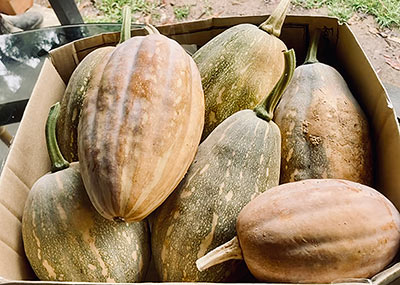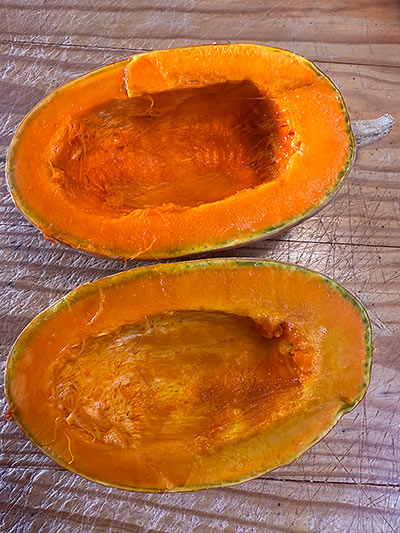Articles
Down the Gramma Rabbit Hole
Gramma Pumpkin: An Heirloom with a Story as Rich as Its Flavour
Gramma pumpkins are one of those near-forgotten heirloom gems that seem woven into the fabric of rural Australian backyard gardens, quietly sprawling across compost heaps, curling their vines over fences, and producing fruit destined for the most nostalgic of desserts—gramma pie. But this humble pumpkin has a story far beyond its place in the kitchen, stretching back through generations of growers, newspaper recipes, and even a sensational trial that scandalised Grafton in 1902.

The Growth Habits of a Classic
Gramma pumpkins (Cucurbita moschata) are vigorous, long-vining plants that thrive in warm climates and well-drained, fertile soil. They require plenty of space, as their sprawling nature sees them reaching several metres in all directions. Large, deeply lobed leaves provide excellent ground cover, shading the soil and suppressing weeds, while their bright yellow flowers attract a flurry of pollinators.
More commonly grown in New South Wales and Queensland, gramma pumpkins are well-suited to Australia’s warmer, humid regions. Unlike some pumpkins that struggle in high heat, gramma pumpkins are particularly resilient, producing well even in tropical and subtropical conditions. Their ability to tolerate heat and humidity makes them a long-time staple in northern home gardens, where they’ve been passed down through generations.
The fruit itself is unmistakable—elongated and slightly bulbous at one end, with smooth skin that ripens from green to a rich golden-yellow. Inside, the flesh is dense, vibrant orange, moist and exceptionally sweet, making it ideal for baking. Unlike some modern hybrids, gramma pumpkins are fantastic keepers, storing well for months after harvest, ensuring that gramma pie can be enjoyed long after the vines have withered.
A Piece of Australian Food History
While the gramma’s origins likely trace back to early European settlement, it has firmly established itself as a staple in Australian country kitchens. In fact, its presence in recipes goes back well over a century. The Australian Town and Country Journal in Sydney, 1885, featured a recipe for gramma pie, proving its place in Australian culinary history long before mass-produced desserts took over. Apparently, the gramma pie had its very own category in the Grafton Show by 1909, does anyone know if this is still the case?
But gramma pie wasn’t always associated with warm family gatherings. In one of the more bizarre intersections of food and crime, the dessert found itself at the centre of a murder trial in 1902. James Dowling of Grafton, convinced that his wife had hidden 50 guineas in a pie and gifted it to another man, took a tomahawk to her in a fit of rage. The case, widely reported at the time, ended with a manslaughter conviction, forever linking gramma pie to one of Australia’s more morbid moments in history.
The gramma is also said to be fantastic stock fodder for all manner of farm animal, and makes for a tasty jam.
Gramma vs. Gramma Trombone
While the classic gramma pumpkin is the most well-known, a close relative, the Gramma Trombone, also thrives in Australian gardens. Named for its long, curved shape resembling a brass instrument, the gramma trombone (Cucurbita moschata) shares many of the same characteristics—sweet, dense flesh, vigorous vining growth, and excellent storage qualities. It’s particularly popular in Italian and Mediterranean cooking, often used in soups and roasts. Both varieties showcase the adaptability and hardiness of the Cucurbita moschata family, proving why these pumpkins have remained garden favourites for so long.
Gramma Pie: A Recipe for Tradition
Thankfully, gramma pie is far better known for its taste than its criminal associations. It remains a favourite in rural Australia, a dish that brings back memories of childhood, country fairs, and handwritten recipe books. If you’ve got a gramma pumpkin on hand, here’s a classic recipe to try (we hear Kent makes an acceptable substitute in a pinch but that would be bucking tradition now wouldn't it!):
Traditional Gramma Pie

Ingredients:
- 1 medium gramma pumpkin (about 1kg of cooked flesh)
- Sugar - traditional recipes say start with one tablespoon and work your way up from there, the fruit is very sweet.
- Optional spices - none/any/all
- 1 tsp ground cinnamon
- 1/4 tsp ground nutmeg
- 1/2 tsp ground ginger
- Optional - Currants or sultanas - a handful or to taste. Some traditional recipes add these.
- 1 tbsp lemon juice
- 2 tbsp butter
- 2 eggs, beaten
- Shortcrust pastry for base and lid. Either storebought or homemade will work.
Method:
- Preheat your oven to 180°C.
- Peel, deseed, and chop the gramma pumpkin into chunks. Simmer in a very small amount of water until soft (gramma is a moist fruit), then drain well and mash until smooth.
- Stir in the sugar, spices, lemon juice, currants if using and butter while the mixture is warm. Allow to cool slightly before adding the beaten eggs. Mix well.
- Line a pie dish with the shortcrust pastry and pour in the pumpkin filling. Cover with puff pastry, crimping the edges to seal.
- Bake for 35-40 minutes or until golden brown.
- Allow to cool slightly before slicing and serving. Enjoy warm with cream or custard. Equally good chilled.
A Pumpkin Worth Growing
Gramma pumpkins are more than just a great ingredient—they’re a living piece of Australian heritage. Their ability to thrive in our climate, their excellent storage qualities, and their rich culinary history make them a must-grow for any gardener interested in heirloom varieties. Whether you’re baking an old-fashioned pie, making a hearty soup, or simply growing them for their history, the gramma pumpkin is a true Aussie classic.
So, next time you see a gramma vine winding its way through the garden, remember: you’re not just growing a pumpkin—you’re growing a piece of history.
**Seeds from this year's harvest are currently drying and will be available shortly!



